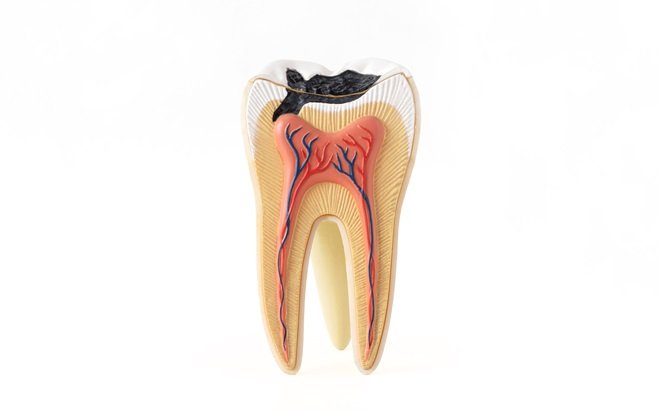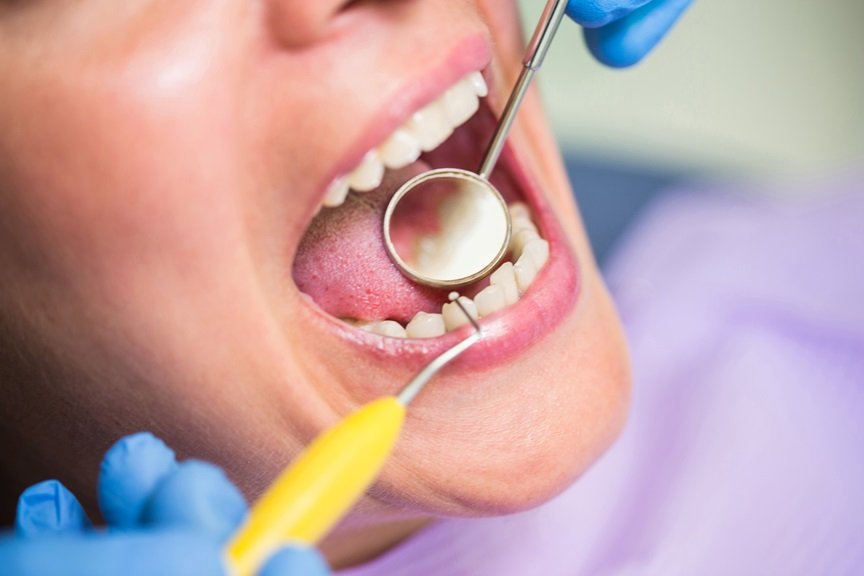Understanding Tooth Cavity Problems
Maintaining dental health is crucial for overall well-being, and one common issue many people face is cavities. Cavities, also known as dental caries, are permanent damage to the hard surface of your teeth that develop into tiny openings or holes.
They can lead to severe toothache, infection, and even tooth loss if left untreated. Therefore, it is essential to address cavities promptly to prevent further complications.
Regular visits to a dental professional are vital in detecting and treating cavities early, ensuring your teeth and gums remain healthy. So lets start by understanding how to remove cavity from teeth.

What Are Cavities?
Cavities are areas of tooth decay that occur when the enamel, the hard outer layer of the tooth, is damaged by acids produced by bacteria in the mouth.
These bacteria feed on sugars from food and beverages, producing acids that erode the enamel and create holes. If left untreated, cavities can penetrate deeper into the tooth, affecting the dentin and pulp, which can lead to pain and infection.
Types of Cavities
- Smooth Surface Cavities: These occur on the smooth sides of your teeth. They are the slowest to develop and can often be prevented with proper brushing and flossing.
- Pit and Fissure Cavities: Found on the chewing surfaces of the back teeth, these cavities develop quickly if food particles and plaque get trapped in the pits and grooves of the teeth.
- Root Cavities: These develop on the root surfaces of teeth, usually in individuals with receding gums, which exposes the roots to plaque and acids. They are common in older adults and those with gum disease.
How Do Cavities Form?
Cavities form through a process that involves the interaction of bacteria, sugars, and acids in the mouth. When you consume sugary or starchy foods, the bacteria in your mouth feed on these sugars and produce acids.
These acids, combined with bacteria, food particles, and saliva, form plaque, a sticky film that coats your teeth. If plaque is not removed through regular brushing and flossing, the acids can erode the enamel, leading to the formation of cavities.
Signs and Causes of Cavities
Signs
- Toothache or spontaneous pain
- Sensitivity to hot, cold, or sweet foods and drinks
- Visible holes or pits in your teeth
- Brown, black, or white staining on any surface of a tooth
- Pain when you bite down
Causes
- Poor Oral Hygiene: Inadequate brushing and flossing can lead to plaque buildup and tooth decay.
- Frequent Snacking or Sipping: Consuming sugary foods and drinks frequently provides fuel for bacteria to produce acids.
- Dry Mouth: Reduced saliva production can lead to less washing away of food particles and bacteria.
- Worn Fillings or Dental Devices: These can break down and allow decay to begin underneath them.
- Certain Foods and Drinks: Foods that cling to your teeth for a long time, such as milk, ice cream, honey, sugar, soda, dried fruit, and chips, are more likely to cause decay.
Risks of Untreated Cavities
Ignoring cavities can lead to serious dental and health complications. When cavities are left untreated, the decay can spread deeper into the tooth, affecting the inner layers and potentially causing infections.
Addressing cavities early is essential to prevent these risks and maintain overall dental health.
- Toothache: Persistent pain can interfere with daily activities and overall quality of life.
- Infection: Untreated cavities can lead to tooth abscesses, which are pockets of pus caused by bacterial infection.
- Tooth Loss: Severe decay can destroy the tooth structure, necessitating extraction.
- Difficulty Eating: Pain and sensitivity can make it challenging to eat and chew properly.
- Spread of Infection: Infections from untreated cavities can spread to other parts of the body, leading to more severe health issues.
- Gum Disease: Cavities can contribute to gum disease, which can affect the tissues and bones supporting your teeth.
How to Prevent Cavities
Preventing cavities involves maintaining good oral hygiene and making lifestyle choices that support dental health.
By incorporating these preventive measures into your daily routine, you can significantly reduce the risk of developing cavities and remove cavity from teeth.
- Brush Regularly: Brush your teeth at least twice a day with fluoride toothpaste to remove cavity from teeth and food particles.
- Floss Daily: Flossing helps remove cavity from teeth and food debris from between your teeth and under the gumline.
- Limit Sugary Foods and Drinks: Reduce your intake of sugary and starchy foods and beverages, which can contribute to tooth decay.
- Use Mouthwash: Rinse with an antibacterial mouthwash to help reduce plaque and bacteria in your mouth.
- Eat a Balanced Diet: Consume foods rich in vitamins and minerals that promote healthy teeth and gums.
- Visit Your Dentist Regularly: Schedule regular dental check-ups and cleanings to detect and treat cavities early.
- Drink Water: Drinking water, especially fluoridated water, can help wash away food particles and bacteria from your mouth.
- Chew Sugar-Free Gum: Chewing sugar-free gum can stimulate saliva production, which helps neutralize acids and wash away food particles.
How to remove cavity from teeth?
Addressing cavities involves a range of treatment options tailored to the severity of the decay.
Early intervention can often prevent further damage and restore dental health. Here is a list of some of the treatments to remove cavity from teeth.
Fluoride Treatments
For early-stage cavities, fluoride treatments are a preventive measure that can help reverse enamel damage before it progresses. Fluoride is a mineral that strengthens tooth enamel and enhances its resistance to acid attacks from bacteria.
During a fluoride treatment, a dentist applies a concentrated fluoride solution, gel, foam, or varnish directly to the affected areas of the tooth. This treatment promotes the remineralization of weakened enamel and can help stop the progression of decay.
Regular fluoride applications, combined with good oral hygiene practices, can significantly reduce the risk of developing cavities.
Dental Fillings
When cavities have advanced beyond the enamel and into the dentin, dental fillings are commonly used to restore the tooth’s function and appearance.
The procedure involves removing the decayed portion of the tooth and to remove cavity from teeth. The space is then filled with a restorative material such as composite resin, amalgam, gold, or porcelain.
Composite resin and porcelain are often chosen for their ability to blend with natural tooth color, while amalgam and gold provide durability.
Fillings not only restore the tooth’s shape but also prevent further decay by sealing off the area from bacteria and food particles.
Crowns
Dental Crowns are used to remove cavity from teeth when cavities are extensive and have caused significant damage to the tooth structure.
A crown, also known as a cap, is a custom-fitted covering that encases the entire tooth above the gum line. The process begins with the removal of the decayed area and reshaping of the tooth to accommodate the crown.
Crowns are made from various materials, including porcelain, ceramic, gold, or metal alloys, depending on the location of the tooth and patient preferences. This treatment provides robust protection, restores the tooth’s strength and function, and improves its appearance.
Root Canals
For cavities that have penetrated the inner pulp of the tooth and caused infection or severe pain, a root canal treatment is often required.
This treatment involves removing the infected or damaged pulp from inside the tooth, followed by cleaning and disinfecting the root canals. After the canals are cleaned, they are filled with a biocompatible material and sealed.
The tooth is then typically restored with a crown to protect it and restore its functionality. Root canals can save a tooth that might otherwise need to be extracted and alleviate pain associated with severe decay.
Tooth Extraction
Tooth extraction is considered when a cavity has caused extensive damage to a tooth that cannot be effectively restored through other treatments. This procedure involves the complete removal of the tooth from its socket in the jawbone.
Extraction may be necessary if the tooth is severely decayed, fractured, or infected beyond repair, or if it poses a risk to adjacent teeth. The process is usually performed under local anesthesia to numb the area, and in some cases, sedation may be used for added comfort.
After extraction, the dentist may discuss options for replacing the missing tooth, such as dental implants, bridges, or dentures, to restore function and prevent shifts in surrounding teeth.
Conclusion
Addressing and treating cavities effectively is crucial for maintaining optimal dental health and preventing more serious complications. There are various procedures designed to restore the health and function of affected teeth.
Each treatment option targets different stages and severities of tooth decay, emphasizing the importance of early detection and intervention.
Regular visits to a trusted dentist not only help in managing existing cavities but also in preventing future dental issues, ensuring a healthy and vibrant smile for years to come.
For the best care and guidance on managing cavities, it’s advisable to consult with American Dental Practices. Our dental professionals can provide personalized treatment plans, employ advanced techniques, and offer preventive advice tailored to your specific needs.
FAQ’s
What are the common signs that I might have a cavity?
Common signs of a cavity include toothache or persistent pain, sensitivity to hot, cold, or sweet foods and drinks, visible holes or pits in your teeth, and brown, black, or white staining on the surface of a tooth.
You might also experience pain when chewing or biting down. If you notice any of these symptoms, it’s important to consult a dentist promptly to address potential cavities before they worsen.
How can fluoride treatments help remove cavity from teeth?
Fluoride treatments are effective in both preventing and treating early-stage cavities. Fluoride strengthens tooth enamel by enhancing its resistance to acid attacks from bacteria.
In cases of incipient decay, fluoride can help remineralize and repair the weakened enamel before it progresses to more severe decay.
Fluoride treatments are typically applied by a dentist in a gel, foam, or varnish form, and they can be especially beneficial for individuals at higher risk of cavities.
What should I expect during a dental filling procedure?
- During a dental filling procedure, the dentist will first numb the affected tooth and surrounding area with a local anesthetic.
- Next, the dentist will remove the decayed portion of the tooth and clean the cavity to ensure all decay is removed.
- The cavity is then filled with a restorative material, such as composite resin, amalgam, gold, or porcelain, which is chosen based on factors like the tooth’s location and the patient’s preferences.
- After filling, the dentist will shape and polish the filling to ensure it fits properly and functions like a natural tooth.
When is a root canal necessary, and what does the procedure involve?
A root canal is necessary when tooth decay has advanced to the point where it infects the pulp, the innermost part of the tooth containing nerves and blood vessels.
This can cause severe pain and lead to an abscess if left untreated. During a root canal treatment, the dentist removes the infected pulp, cleans and disinfects the root canals, and then fills and seals them with a biocompatible material.
After the root canal, the tooth is usually restored with a crown to protect and strengthen it. This procedure can save a tooth that might otherwise need to be extracted and alleviates pain caused by deep decay.
Focus on your Smile, Not Cavities!
Take Steps Towards Cavity Free Teeth! Book Now.







